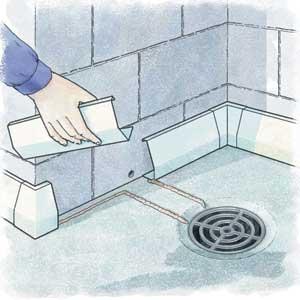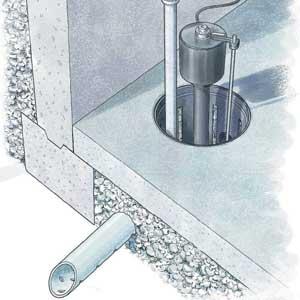You can cure most water problems with a few simple, low-cost steps.
A wet basement is more than a nuisance. If your basement includes finished living space, any kind of moisture can ruin carpeting, drywall, and framing. Even if you have a crawl space or just use your basement for storage, a simple case of condensation can buckle hardwood flooring on the level above and spawn harmful mold.
If you have a soggy basement, you’re not alone. The American Society of Home Inspectors, based in Des Plaines, IL, estimates 60 percent of U.S. homes have wet basements, and 38 percent run the risk of basement mold.
The water most often comes from rainfall and melting snow. Even a small storm can trigger a deluge a house with a 1,500-square-foot roof sheds 1,000 gallons of water for every inch of falling rain. In tougher cases, the problem is rising groundwater, which may even be fed by an underground spring. Once the water accumulates around your foundation, it works its way inside through cracks, joints, and porous material.
A pro cure can cost from a few hundred dollars to many thousand. But even if you’re knee-deep in water, don’t call your banker yet. You can solve most wet-basement problems yourself for significantly less than you’d pay a professional. The key is to determine which of the three major problems you have: condensation, runoff, or subsurface seepage.
Condensation

EXTEND DOWNSPOUTS at least 4 ft. away from the house and install a splash block to help disperse the water.
Also called sweating, condensation shows up as water droplets, wet spots, or puddles on basement floors and walls. It happens when moist, warm air hits cool foundation walls or uninsulated cold-water pipes, dampening carpets, rusting appliances, and turning the basement clammy. In crawl spaces, condensation encourages wood rot and insect attack, and can buckle and delaminate plywood.
Diagnosis:Â Condensation is easy to confuse with runoff or subsurface water. To tell it from the others, tape foil over damp spots and check it after a day. If moisture forms on the outer foil face, water is condensing from the air. If moisture forms on the foil underside, water is seeping in from outside.
Simple cures:Â Start with the easy stuff. If you have a full basement, air it out by opening windows and running fans. Also consider installing a dehumidifier (about $230 for a heavy-duty unit that will process 50 pints in 24 hours), ideally in a spot near easy drainage. Some experts argue that lowering the humidity in a basement will draw more moisture in, because moisture naturally migrates from higher humidity levels to lower ones. But as Chris Carter, of Ever-Dry in Fort Wayne, Indiana, explains, “The dehumidifier may draw in 10 to 20 percent more moisture, but it can easily process it.” Bottom line: a drier basement.
During colder months, turn up the heat in the basement. Also insulate all cold-water pipes with foam insulation to keep moist air from contacting them, and be sure the clothes dryer vents to the outside with no duct leaks. Finally, don’t dry clothes on a line in the basement or store wet firewood there.
If your home has a crawl space rather than a full basement, cover the ground in the space with plastic sheeting 6-mil polyethylene is the most durable and generously overlap seams. You may also want to consider increasing the number of foundation vents to promote air circulation that will carry moisture away.
Severe cases:Â If you continue to see moisture after trying these cures, then you’re not dealing with condensation.
Runoff

A dry well fed by a 4-in. PVC pipe running from downspouts can disperse the water gathered from the roof. It should sit on a gravel bed and be wrapped with landscape fabric that holds out silt.
Rainwater or melted snow that isn’t routed away from the house is the most common cause of basement and crawl space moisture. Runoff percolates through porous topsoil and then stops at the compact soil near the base of the foundation. Hydrostatic pressure forces the water through gaps or cracks in walls and footings. Water also moves through porous walls by capillary action.
Diagnosis:Â A damp crawl space or wet basement walls and floors just after a storm or as snow melts are telltale signs the problem is runoff.
Look for ways runoff can enter your basement or crawl space. Check that the ground outside slopes away from your house at least 1 inch vertically for every 1 foot of horizontal travel. Then make sure downspout runoff isn’t pooling or percolating into soil near the foundation during a storm, and that downspout seams aren’t leaking; installing downspouts seams-out makes this check easy.
Next, check that driveway curbs are channeling runoff to the street. Look for unsealed cracks on the driveway surface, which can allow water to collect below grade. Some houses on hilly sites have a swale a shallow trench with gently sloping sides and a gravel bed covered by topsoil and grass. The swale catches runoff, channeling it past the house or off to other drain systems. Unfortunately, a swale can eventually clog with silt. So can the original underground footing drains buried at the base of your foundation.
Simple cures:Â If you’re dealing with a full basement, start by patching cracks in the foundation and sealing basement walls. Use a polyurethane masonry caulk.
For both basements and crawl spaces, you need to address outside entry points next by patching cracks in the driveway using cold-mix asphalt patching compound. For a concrete sidewalk or driveway, use ordinary cement.

Interior gutter systems catch basement water and channel it to floor drains or a sump pump. Epoxy seals the channel to the floor; the same glue can create curbs to route the flow to a drain.
Also clean gutters so they won’t overflow. (If your home is not equipped with gutters, install them.) And make sure the soil around the foundation slopes away from the house 1 inch per foot for a distance of 4 feet. And add downspout extensions if needed so gutters drain 4 feet away from the house onto splash blocks.
Many homes have an existing underground drainage system. Unfortunately, the system often breaks apart or fills with silt after several decades. You can call in a drain-and-sewer-cleaning contractor who will use a long power snake to try to clear the lines. But often they just have to be capped off at the surface and abandoned.
Instead, drain rainwater from gutters into a dry well a hole lined or filled with gravel or a tank that allows runoff to soak into the ground slowly. The Flo-Well system (about $150), which features a plastic tank wrapped with polypropylene fabric to block silt, is a typical residential dry well. It can handle runoff from a 500-square-foot section of roof. Install a dry well at least 10 feet from the house in a hole 3 feet deep. Then cover it with soil and put a plant on top to mark its location should the system back up. Planting grass alongside your house is another way to absorb excess water. But don’t plant trees; their roots can damage the foundation and an underground drainage system.
Severe cases:Â If water is still gushing into your basement, call in a professional. Otherwise, consider an interior gutter. This dam-and-channel system goes around the perimeter of the basement floor and collects water that flows down or through the walls or floor, routing it to a floor drain or sump pump.
Subsurface Sources

For sever seepage: Interior footing drains made of perforated pipe set in gravel carry water to a sump pump, which pumps it out of the basement.
If your wet-basement symptoms act like runoff but occur all the time, you’re probably dealing with high groundwater.
Diagnosis:Â Unless the foundation is surrounded by soil that has a high clay content, which can hold rainwater and snowmelt for months, runoff problems usually come and go as storm water drains away. But if your basement is consistently wet long after a storm, or if water is flowing through your walls or bubbling up where the walls meet the floor, you probably have a subsurface water problem. Check with your city or town to see if the water table is unusually high in your area or if underground springs are common.
Curing it:Â You may want to call a pro for these problems. Solutions range from the relatively simple (injecting absorbent clay into the soil and urethane caulk into cracks, $500 and up) to the more involved (creating a sump and installing a sump pump, which costs about $300 to $700).
A contractor may also suggest combining a sump pump with perimeter drains made of 4-in. perforated PVC drainpipe laid in gravel inside foundation footings. These interior systems, which channel away water before it enters, require extensive jackhammering and roughly cost $3,000 to $5,000. Exterior systems, which run at the base of footings, are even more complicated; they require removing the landscaping, excavating to expose the foundation, covering it with a waterproof membrane and laying perimeter footing drains in a bed of gravel. This can easily cost up to $10,000.
Considering the high cost of quelling subsurface water, doing it right is crucial.
• Be sure the contractor is insured and offers guaranteed work.
• Get a firm or not-to-exceed price with detailed specifications.
• Ask three past clients the following: Would you use the contractor again? Did he solve the problem? And, did he respond promptly to callbacks?
If you are looking for Rhode Island remodeling contractor, please call us today at 401-434-6600 or complete our online request form.
|